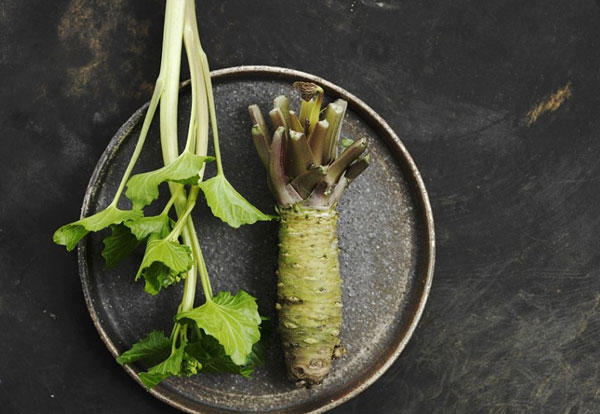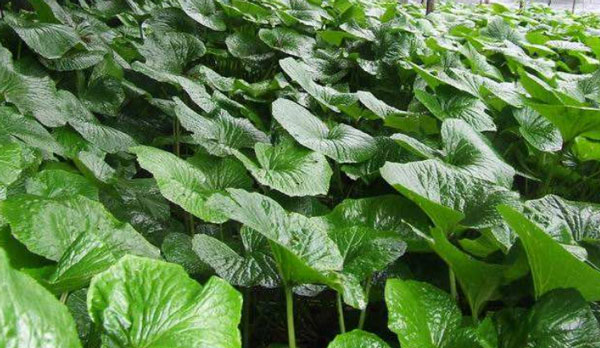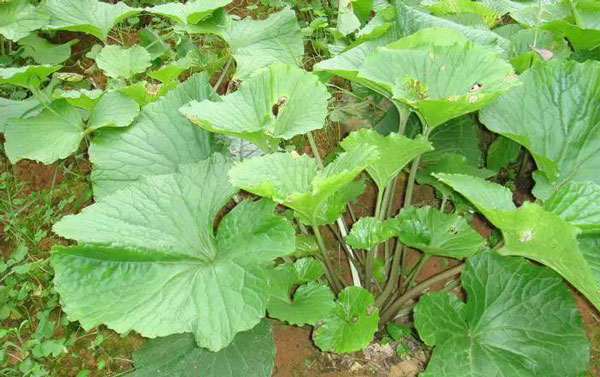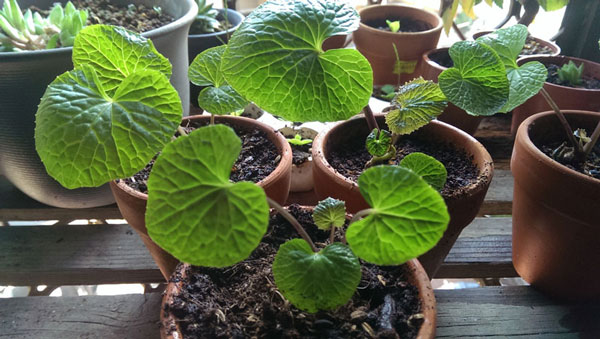Wasabi: Grow & Care for Wasabia japonica
Written by Iris
Sep 16 2021

Wasabi (Wasabia japonica) is a perennial herb that usually grows in mountain streams in Japan. When ground, Wasabi (Wasabia japonica) produces a green juice or paste. Wasabi (Wasabia japonica) is known for its richness, pungency, flavor, or kick. Wasabi (Wasabia japonica) has a taste similar to hot mustard and is most often eaten as a condiment in Japanese cuisine.
If you're growing it in a hot climate, you can use artificial cold treatment to germinate seeds. It was found that varieties like ‘Daruma’ and ‘Shimane’ started well when exposed to 41 F (5 C) for 2 months. For this, you can keep wasabi seeds in the refrigerator. Plant wasabi outside, when the temperature is around 50-55 F (10-13 C).
If you are lucky enough to get seeds, soak them overnight in water and plant them in seed raising mix in the morning. Keep the mix moist until they germinate.
Plant seeds in late winter or early spring when temps are in the 50s to give them time to strengthen.
Start them indoors in containers in the middle of winter. Once the wasabi is at least six inches tall, you can plant in the garden or bigger containers.
Suggest starting a bunch more seeds than you expect to need because you’re likely to have some failures along the way.
Temperatures below freezing or above 80 degrees Fahrenheit can kill the plant, so these extremes should be avoided. Some coastal locations, such as the Pacific Northwest, provide the suitably cool, temperate weather for growing wasabi. Planting in containers means you can move the plants if the thermometer suddenly gets too high or too low.
'Daruma' is more tolerant of high temperatures than most varieties.
'Fuji Daruma' is a fast-growing variety, ready to harvest in the same year it is planted.
'Green Thumb' is a good choice for edible leaves.
'Sanpoo' was developed to grow well in poor soils.
'Mazuma' is a slow-growing variety that takes up to three years for the roots to mature.
One of the reasons wasabi is so difficult to cultivate is because it needs a constant water source. In nature, water flows over wasabi, and it's difficult to replicate this process in gardens.
It can also be difficult to find wasabi seeds or cuttings to grow from. If you do, you have to care for the plant meticulously, ensuring it doesn't get exposed to too much humidity or nutrients. Everything needs to be just right for wasabi to grow successfully, so gardeners must be serious about the plant to have success in growing wasabi.
The wasabi plants do grow in full size by the summer that can be distinguished by the large heart-shaped leaves and its tall structure does make other plants around it scuffle for light.
The leaves do live on for the next six months until the winter season and the plant's materials do travel downwards into the rhizomes located beyond the ground where it is conserved.
Where to Grow WasabiWhen to Grow WasabiHow to Grow WasabiWasabi Propagation with SeedsWasabi Propagation with PlantletsHow to Care for WasabiLight CareSoil CareWater CareTemperature & Humidity CareFertilizer CarePruning CarePests & Diseases CareVarieties of WasabiWasabi FAQWhy is Wasabi Difficult to Grow?How and When to Harvest Wasabi?What Does Wasabi Taste Like?
Where to Grow Wasabi
In the U.S., wasabi doesn't grow well outdoors in most regions, but it does well in temperate areas like the Pacific Northwest. That said, wasabi will grow anywhere in small quantities if you're willing to do some extra work to keep it happy. You have to be mindful of temperature rather than zones. Wasabi likes to be not too hot and not too cold. If the temperature exceeds 80°F or goes below 32°F, you'll need to take action. You can do things like adding shade cloth or moving the wasabi indoors. If you regularly get outside of these temperatures throughout the year, you'll probably need to grow indoors.When to Grow Wasabi
According to wasabi growers, the best time for planting is late fall and up to early or mid winters as wasabi seeds need cold winter temperatures to break dormancy, around 2 months before they sprout in February.If you're growing it in a hot climate, you can use artificial cold treatment to germinate seeds. It was found that varieties like ‘Daruma’ and ‘Shimane’ started well when exposed to 41 F (5 C) for 2 months. For this, you can keep wasabi seeds in the refrigerator. Plant wasabi outside, when the temperature is around 50-55 F (10-13 C).

How to Grow Wasabi
Wasabi Propagation with Seeds
Wasabi seeds can be hard to get hold of and, unfortunately, many seeds for sale out there aren’t true wasabi. They’re actually mustard, wasabi mustard, or arugula wasabi.If you are lucky enough to get seeds, soak them overnight in water and plant them in seed raising mix in the morning. Keep the mix moist until they germinate.
Plant seeds in late winter or early spring when temps are in the 50s to give them time to strengthen.
Start them indoors in containers in the middle of winter. Once the wasabi is at least six inches tall, you can plant in the garden or bigger containers.
Suggest starting a bunch more seeds than you expect to need because you’re likely to have some failures along the way.
Wasabi Propagation with Plantlets
Wasabi is easy to propagate because of the way the plants grow. Small plantlets develop around the crown of the plants. These plantlets are broken off at the time of harvest and replanted. This can be done for only a few years due to disease. The wet environment that the plants grow in encourages disease. Because the plants require such a specialized environment to grow in, it is not possible to use crop rotation to prevent the disease from infecting both the mother plants and the plantlets. After a few years, fresh plants that are not infected with the disease must be grown from seed.
How to Care for Wasabi
Light Care
Direct sunlight is not tolerated well by wasabi, so make sure the plants are shaded. You can create a shade barrier with fabric (shade cloth) or a folding screen. Container plants can be moved around to keep them in the shade.Soil Care
Wasabi does best when it’s growing in shallow, cold, clear running water. Not everyone has a shady, cool, stream running in their yard, however. Instead, you can grow wasabi in soil without the moving water, provided that you keep it moist. If you plant wasabi in the garden, aim for well-draining soil that you can keep consistently damp. A pH of 6 to 7 is best. You can also plant wasabi in a hydroponic setup.Water Care
Deep and regular watering is required to keep the soil moist and maintain humidity and coolness around the wasabi plant. Overwatering and plant sitting in wet soil must be avoided to prevent root rot, especially if you’re growing wasabi indoors.Temperature & Humidity Care
One important consideration for growing wasabi is that it tolerates only a narrow temperature range, preferring constant temperatures of 45-75 degrees Fahrenheit.Temperatures below freezing or above 80 degrees Fahrenheit can kill the plant, so these extremes should be avoided. Some coastal locations, such as the Pacific Northwest, provide the suitably cool, temperate weather for growing wasabi. Planting in containers means you can move the plants if the thermometer suddenly gets too high or too low.
Fertilizer Care
The addition of compost or well-rotted manure is enough, but you can also add a slow-release fertilizer like 12-12-12 at the time of planting. Barely, the dose 1 to 1.5 grams per square foot is enough for 3-4 months. Feeding with balanced liquid fertilizer rich in sulfur is also an option.Pruning Care
Prune away wilted, dead, damaged and diseased leaves from the plant, as they can attract pests and diseases.Pests & Diseases Care
Wasabi is a member of the Brassica family. Pests and diseases of this family include aphids, cabbage, and alfalfa looper larva, crane fly larva, and slugs. The best defense against pests and disease is to maintain the cool temperatures and stable irrigation wasabi prefers. Pruning wilted or diseased foliage, hand removal of slugs or use of slug bait, and removal of aphids and other pests are beneficial to the plant's health. Use caution when using any insecticidal soap or any other insecticides. If any fungal disease is detected it is recommended to remove the plant away from all others to try treating it, or dispose of the plant entirely. Copper spray can be useful in the presence of any fungal complications.
Varieties of Wasabi
There are a number of popular cultivars of wasabi, including:'Daruma' is more tolerant of high temperatures than most varieties.
'Fuji Daruma' is a fast-growing variety, ready to harvest in the same year it is planted.
'Green Thumb' is a good choice for edible leaves.
'Sanpoo' was developed to grow well in poor soils.
'Mazuma' is a slow-growing variety that takes up to three years for the roots to mature.

Wasabi FAQ
Why is Wasabi Difficult to Grow?
Wasabi is known to gardeners as one of the most difficult plants to grow. It grows on its own in rocky riverbeds in Japan, but gardeners are often unsuccessful in attempting to grow it in their gardens.One of the reasons wasabi is so difficult to cultivate is because it needs a constant water source. In nature, water flows over wasabi, and it's difficult to replicate this process in gardens.
It can also be difficult to find wasabi seeds or cuttings to grow from. If you do, you have to care for the plant meticulously, ensuring it doesn't get exposed to too much humidity or nutrients. Everything needs to be just right for wasabi to grow successfully, so gardeners must be serious about the plant to have success in growing wasabi.
How and When to Harvest Wasabi?
The size of the plants will be almost close to two feet tall and almost two feet wide after it has completely grown.The wasabi plants do grow in full size by the summer that can be distinguished by the large heart-shaped leaves and its tall structure does make other plants around it scuffle for light.
The leaves do live on for the next six months until the winter season and the plant's materials do travel downwards into the rhizomes located beyond the ground where it is conserved.
What Does Wasabi Taste Like?
The taste of wasabi is identical to hot mustard or horseradish. Sometimes, it is also used as a substitute for chili pepper. It tastes close to Western horseradish. Spicy and hot for a moment but a bit sweeter and smooth than horseradish, and taste doesn't linger.Latest Updated
- Benefits of Bugleweed - 7 Science-backed Health Benefits
- Bugleweed Dangers & Side Effects - Is It Poisonous?
- How to Plant Evergreen Trees - What You Should Know
- When to Plant Evergreens - Grow Guide for Evergreen Trees
- 12 Wonderful Evergreen Shrubs for Your Garden
- 12 Popular Evergreen Plants with Pictures for Beginners
- When And How To Prune A Lilac Bush Like a Pro
- How to Grow & Care for Lilac Vine (Hardenbergia Violacea)
- Japanese Lilac Tree (Syringa Reticulata) Care & Propagation Guide
- Shumard Oak Pros and Cons - What to Know
Popular Articles
- Winter maintenance of Antirrhinum Majus
- How to Grow Terminalia Mantaly Tree
- How to Grow and Care for Crossostephium Chinense
- How to grow Antirrhinum Majus in spring
- Peristeria Elata (Dove Orchid) Profile: Info & Care Guide
- Underwatered Snake Plant (Sansevieria Trifasciata) - Signs And How To Fix
- How to Care for Brazilian Jasmine Plant (Mandevilla Sanderi)
- How to Grow & Care for Graptopetalum Purple Delight in Summer
- Rosa Chinensis (China Rose): Plant Growing & Care Tips
- How to Care for Baby Sun Rose (Aptenia Cordifolia)